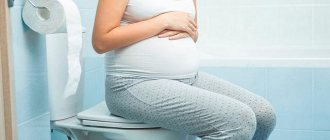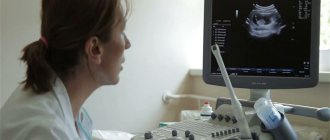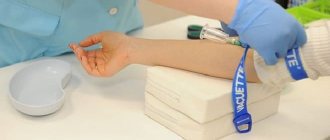Very often, such a wonderful period of waiting for a baby is overshadowed by the appearance of various dyspeptic disorders, causing in some cases periodic or constant discomfort, and in some cases - serious disorders accompanied by pain in the epigastric region. Diseases of the upper gastrointestinal tract (GIT) in pregnant women are characterized by a wide variety of symptoms and, in most cases, the absence of a clear clinical picture.
The last factor is associated with physiological changes occurring in a woman’s body:
- displacement of the stomach or intestines due to fetal growth;
- hormonal changes;
- sudden changes in taste preferences.
Gastroscopy during pregnancy is undoubtedly the most informative diagnostic technique, the implementation of which, however, is quite difficult for a woman. In this regard, gastroscopy should be used for diagnosis only for special indications or in the absence of any effect from previous treatment.
Indications for examination
It is a mistake to believe that the procedure is carried out only for preventive purposes. In fact, gastroscopy is prescribed to a pregnant woman in order to:
- determine the source of bleeding in the stomach;
- identify the worsening of the harmful process in the gastrointestinal tract;
- in case of severe symptoms, diagnose the patient, especially if this is not possible without additional examination.
FGDS is also prescribed to a woman during pregnancy if she suspects cancer. During the procedure, the doctor will take a biopsy (a sample of mucosal tissue). This makes it possible to distinguish a benign formation (for example, a polyp on the wall of the stomach) from a malignant one.
Possible restrictions
Gastroscopy during pregnancy is prescribed if there is a suspicion of stomach problems. It is this technique that allows you to avoid making a mistake with the diagnosis. Determining the disease solely by external symptoms is difficult, since many pathologies of the gastrointestinal tract have similar clinical manifestations.
Before conducting the examination, it is important to consult a gynecologist. Typically, FGDS is recommended to be taken at the end of the first or beginning of the second trimester. At this time, the impact of the device on the fetus is minimal.
It is worth noting that gastroscopy is a safer procedure than radiography. It is better to refuse such diagnostics while expecting a baby.
Rules for preparing a pregnant woman
During the period of bearing a child, a woman is not in a stable psychological state. Therefore, even fibrogastroduodenoscopy by an experienced diagnostician can cause stress in the expectant mother.
In this case (if FGDS cannot be avoided), we recommend that you go to a good medical center and undergo gastroscopy with sedation. During medicated sleep, which will in no way affect your well-being and the health of your baby, the doctor will be able to determine the development of gastrointestinal disease and take a biopsy.
There are 4 important nuances, the observance of which will increase the information content and reliability of the survey:
- Before doing FGDS, we advise you to stop eating smoked meats, pickles, marinades and spicy foods for a few days.
- You should not eat 10-12 hours before the procedure. That is why it is very important that the expectant mother goes for diagnostics in the morning. Most patients believe that an empty stomach only reduces the intensity of vomiting. This is true, but the procedure, done on an empty stomach, reduces to zero the risk of vomit getting into the respiratory system.
- You are not allowed to smoke on the day of the procedure.
- Gastroscopy during pregnancy is a real stress. Therefore, we recommend that on the eve of the FGDS you sit down and write down all the medications that you took and are taking during the period of gestation.
Should I consult a female doctor?
Despite the fact that many doctors believe that performing an FGDS in the first and early second trimester is safe, you still need to consult with the specialist who is managing your pregnancy. The gynecologist will weigh the pros and cons and give a final answer. In this case, his decision will be based on factors such as:
- the course of pregnancy;
- condition of the expectant mother;
- concomitant diseases;
- condition and development of the fetus;
- the woman’s age (gastroscopy is not the best option for older pregnant women);
- how urgently it is necessary to carry out the diagnosis (in other words, is it possible to endure the FGDS procedure until delivery).
To avoid serious consequences, you may need to undergo additional ultrasound examination.
Contraindications
The diagnostic method of gastroscopy does not harm the body and health of a pregnant woman. In some cases, the procedure is postponed or alternative examination methods are used:
- FGDS of the stomach is not done if there is severe pain in the gastrointestinal tract during an exacerbation of a chronic disease. This creates a risk of complications.
- The doctor takes into account the condition of the woman and child, the course of pregnancy, and what week the pregnancy is. If there are prohibitions from the gynecologist, it is better not to conduct an FGDS examination.
Fibrogastroduodenoscopy during pregnancy is not an easy procedure. But diagnosing using this method makes it possible to correctly identify the disease and prescribe a course of treatment. Pregnancy is not a contraindication to FGDS. An experienced specialist and a positive attitude of the expectant mother will help carry out the procedure in an informative and painless manner.
Various ailments sometimes prevent the expectant mother from fully enjoying her pregnancy. Women often experience discomfort due to painful sensations in the stomach, so gastroenterologists insist on performing an FGDS during pregnancy. It is worth saying that, contrary to existing opinions, the procedure is safe for both mother and child. However, there are a number of nuances that you should be aware of.
In today's article you will learn about the indications for FGDS during pregnancy and the rules for preparing for the examination. This will help you avoid the development of gastritis and ulcers.
Features during pregnancy
- If gastroscopy is performed without immersion in medicated sleep, then the woman lies on her left side and clamps a special mouthpiece in her teeth.
- She then applies an anesthetic to the back of her throat. For pregnant women, it is recommended to use lidocaine in the form of a spray.
- After 3-5 minutes, a flexible endoscope with a camera at the end is inserted.
- Carrying out this not the most comfortable procedure allows you to choose an effective treatment regimen.
If you suspect that the gastrointestinal tract has been colonized by Helicobacter pylori, you will need to take a breath test. But don’t be afraid, because it is absolutely harmless and painless.
As you understand, it is best to do FGS in the first two trimesters. After the thirtieth week, the indications must be too serious for the doctor observing you to give permission for the procedure. For example, bleeding in the stomach.
Gastroscopy in early and late pregnancy
Features of gastroscopy
Despite the fact that fibrogastroduodenoscopy is considered a relatively new diagnostic method of research, every year the equipment becomes much better and more convenient. The essence of the procedure is to visually (the image is displayed on the monitor) assess the condition of the initial parts of the gastrointestinal tract. Many people are interested in whether it is possible to do FGDS during pregnancy. To answer this question, you need to understand the features of the procedure.
Gastroscopes equipped with a high-resolution camera are made from various materials, and they differ in length and diameter. In addition to this, there are tools that allow you to perform therapeutic manipulations, for example, a biopsy (taking material for subsequent examination under a microscope), right during the examination.
Qualified gastroenterologists perform gastroscopy quickly (no longer than 5-8 minutes) and almost painlessly if the person is properly prepared and follows all the recommendations. There is no need to wait long for the results of the study, since the endoscopist gives his expert opinion almost immediately after its completion. The data obtained should be passed on to your doctor to determine further tactics.
FGDS during pregnancy
A pregnant woman, like any other, may have various diseases, including those of the gastrointestinal tract. Moreover, some symptoms may worsen in this position, significantly affecting her quality of life.
The question of whether pregnant women can have gastroscopy can only be answered by the specialist who deals with them, which is also true for ordinary patients. This is due to the fact that each person has his own characteristics of the body and life activity.
It is believed that FGDS is allowed during pregnancy at any stage in the absence of absolute contraindications to this - they are also determined by the doctor after questioning and examining the woman.
The main problem is changes in hormonal levels, which directly affects the psychological status of the pregnant woman (severe fear, unreasonable anxiety, emotional lability appears), therefore, in potentially mild cases, it is recommended to postpone the procedure until the birth of the child.
Most often, gastroscopy during pregnancy is performed in the presence of several doctors, in addition to the diagnostician. This could be an obstetrician-gynecologist or an anesthesiologist who can quickly respond and provide assistance in unexpected situations. After completing the study, you should not eat for another 2-3 hours, since the mucous membrane of the gastrointestinal tract has been severely irritated due to instrumental intervention. For some time, a woman may experience nausea and a slight sore throat, which goes away on its own.
Indications
Fibrogastroduodenoscopy during pregnancy may be prescribed if the following complaints are present:
- Severe dyspeptic syndrome - nausea, vomiting (especially with blood), severe pain in the upper abdomen, sour belching, formation of aphthae on the tongue (ulceration), constant heartburn, loss of appetite, perversion of taste;
- Dramatic weight loss with intact or even increased appetite, which is very dangerous in the early stages of pregnancy;
- Severe weakness, dizziness, “flickering spots” before the eyes (signs of anemia);
In most cases, symptoms are relieved empirically, without resorting to instrumental studies. However, they can be so pronounced that the woman’s condition deteriorates sharply. This may indicate a more serious pathology that requires immediate treatment.
Therefore, gastroscopy during pregnancy is performed for the following indications:
- Verification (confirmation) of the diagnosis of the disease, as well as the stage of the pathological process:
- If there are ulcers in the stomach and/or duodenum;
- With a large number of polyps, as well as their ulceration;
- Determining the source and cause of internal bleeding;
- Suspicion of a malignant tumor;
- Lack of information content of other research methods;
- The need to perform surgical intervention on the abdominal organs.
During the endoscopic examination, the doctor can perform minimally invasive treatment on site in mild cases or take biological material for histology.
Preparatory stage
In order for the procedure to be relatively comfortable and successful, a woman needs to properly prepare for it. All recommendations should be provided to her by her attending physician or obstetrician-gynecologist.
FGDS is the “gold standard” for diagnosing gastrointestinal diseases, so the procedure cannot be delayed or avoided.
When determining the indications for conducting a study in relation to pregnant women, the doctor scrupulously evaluates the benefits and risks, so there is no need to doubt it. Timely treatment will help avoid serious complications in the future, which can be dangerous for the fetus.
Gastroscopy during pregnancy is carried out after completing the following preparatory measures:
- The last meal on the eve of the study should be no later than 8 hours. This is due to the fact that gastroscopy is most informative only when the stomach and small intestine are empty;
- During the fasting period, you can drink still mineral water, but not before the procedure;
- Drinking alcohol, smoking, as well as unauthorized use of any medications is strictly prohibited;
- The doctor should be informed about concomitant diseases, including allergies to medications;
- Before FGDS, pregnant women must undergo blood tests and evaluate its coagulability (coagulogram);
- You should come to the examination in comfortable clothes, remove lenses, jewelry (especially from the neck area) and removable dental structures.
The main recommendation is to normalize your emotional state. In the absence of contraindications, the pregnant woman is put into medicated sleep, which virtually eliminates the occurrence of unpleasant sensations.
Contraindications
The doctor conducts an explanatory conversation with each pregnant woman, during which it is necessary to ask him any questions of interest in order to dispel all doubts. The specialist will tell you in detail whether gastroscopy can be done and how it goes. The issue of contraindications is decided only on an individual basis.
The following points are taken into account:
- Woman's age;
- Gynecological history. This group of factors includes the total number of pregnancies, births, their course, cases of miscarriages, spontaneous abortions and complications of pregnancy (preeclampsia, eclampsia) in a particular woman;
- The course of this pregnancy, gestational age (“age” of the fetus in weeks);
- The severity of the condition, which necessitates the need to do an FGDS to determine further tactics for managing the pregnant woman;
- Accompanying illnesses.
How to behave after the examination
In order to recover as quickly as possible after gastroscopy, a pregnant woman needs to follow these rules:
- Half an hour after FGDS, you need to drink 1-2 glasses of liquid. In this case, water is supplied at room temperature. The fact is that too hot or cold liquid can cause irritation of the mucous membrane.
- Eating is allowed only 2 hours after the procedure.
- During FGDS, minor throat injuries are possible. However, they can cause discomfort and pain to a pregnant woman for several days. To avoid this, experts advise expectant mothers to drink 1 tsp. sea buckthorn oil before each meal. The remedy will be especially useful if it is painful for a pregnant woman to swallow after gastroscopy.
After mechanical damage to the throat, it is very important to pay close attention to your health and, at the first even minor complaints, consult a therapist. The fact is that injured mucous membranes increase the risk of bacteria and viruses entering the body. But no pregnant woman wants to swallow medications that are not the safest for her baby. In addition, the risk of sore throat increases significantly.
Now you know about the features of gastroscopy for pregnant women. We remind you that it is best to carry out FGDS in the early stages and only with appropriate indications. After all, vomiting and heartburn, which are symptoms of diseases of the gastrointestinal tract, may in fact be a normal option for one or another expectant mother.
WHAT IS THE PROCESS OF RESEARCHING THE GASTROINTESTINAL TRACT?
The FGDS procedure is one of the most accurate diagnostic techniques for studying the digestive system. The procedure is indicated for patients who exhibit symptoms such as abdominal pain, heartburn, as well as nausea and belching. A gastroscopic examination is carried out to identify the causes of the development of these symptoms. Gastroscopy has many advantages over other research methods. The disadvantage of such a study is that the procedure is not very pleasant, as it contributes to the development of gag reflexes when swallowing the probe.
The principle of the study is that a probe, which is an elastic hose with a camera at the end, is inserted into the patient through the oral cavity. This tube is inserted through the esophagus and directed to the stomach and, if necessary, to the duodenum. The doctor watches a picture of what is happening inside the patient on the monitor. In this way, it is possible not only to identify the location of the ulcer or tumor, but also to carry out medicinal treatment.
Based on the FGS results, the doctor makes a diagnosis and prescribes appropriate treatment. It should be noted that the effectiveness and possibility of recovery depends on the timing of diagnosis of illnesses. The sooner measures are taken to cure a particular disease, the more effective the recovery process will be. Gastroscopy during pregnancy is no less important, especially if a woman has indications for it.
If there is a need, the doctor takes mucus from the stomach, which will be examined in detail in the future. This is done in most cases, which makes it possible to differentiate benign types of neoplasms from malignant ones.











